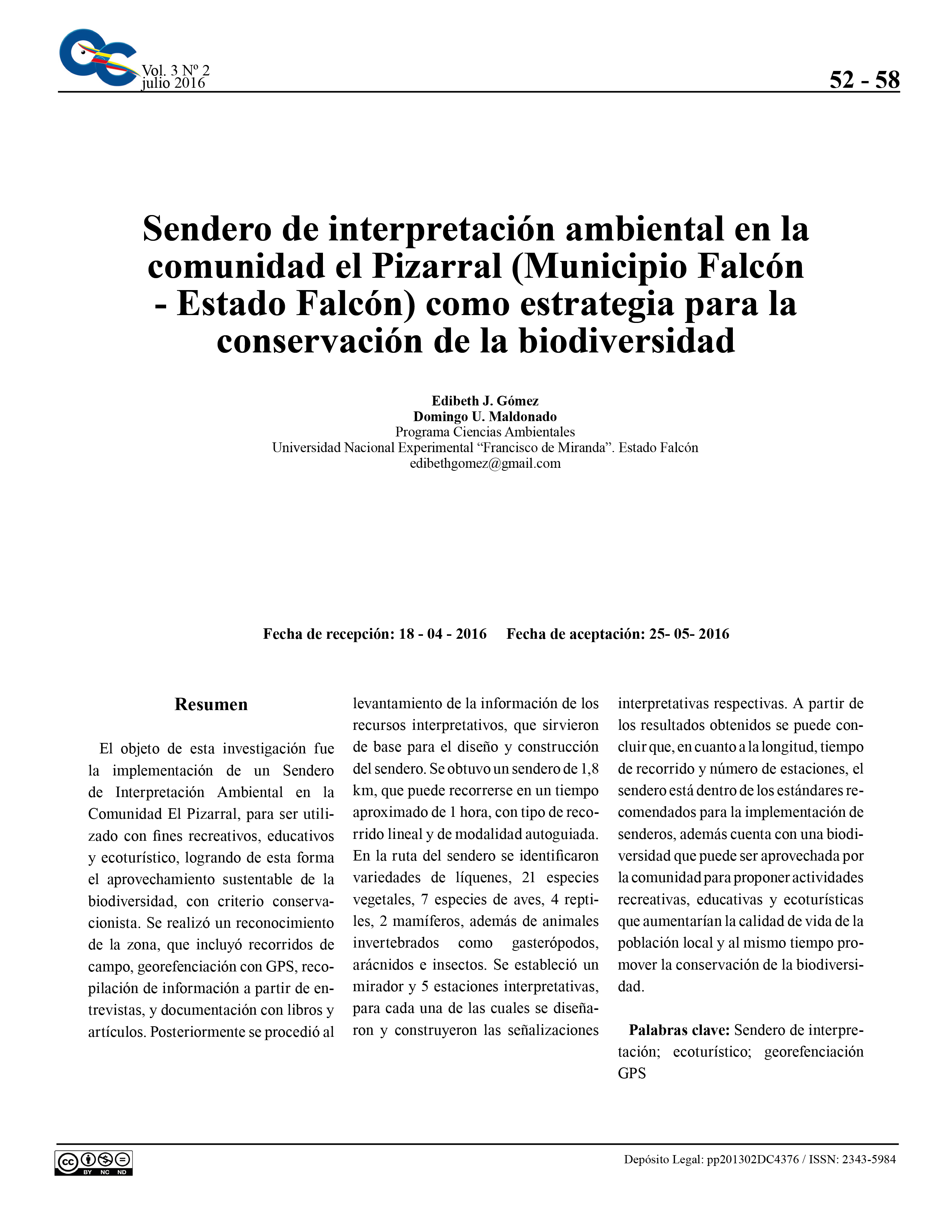Environmental interpretation trail in the community El Pizarral (Falcon municipality - Falcon state) as a strategy for biodiversity conservation
Keywords:
Interpretation trail, ecotourism, georeferencing GPSAbstract
The purpose of this research was the implementation of an Environmental Interpretation Trail in the community of El Pizarral, to be used for recreational, educational and ecotourism purposes, thus achieving the sustainable use of biodiversity, with conservationist criteria. A reconnaissance of the area was carried out, which included field trips, georeferencing with GPS, information gathering from interviews, and documentation with books and articles. Subsequently, the information on the interpretive resources was collected, which served as the basis for the design and construction of the trail. A 1.8 km trail was obtained, which can be walked in approximately 1 hour, with a linear and self-guided route. Along the path, varieties of lichens, 21 plant species, 7 bird species, 4 reptiles, 2 mammals, as well as invertebrate animals such as gastropods, arachnids and insects were identified. A lookout point and 5 interpretive stations were established, for each of which the respective interpretive signs were designed and built. From the results obtained, it can be concluded that, in terms of length, travel time and number of stations, the trail is within the recommended standards for trail implementation. It also has a biodiversity that can be used by the community to propose recreational, educational and ecotourism activities that would increase the quality of life of the local population and at the same time promote the conservation of biodiversity.
Downloads
References
Astudillos C. C. (2007). Diseño e Implementación de un Programa de Educación Ambiental en el Parque Sierra Nanchititla, Luvianos, estado de México. Tesis de Grado presentado como requisito para optar al título de Bióloga. 81 pp.
Coutiño B. y A. L. Montañez. (2000). Los líquenes. Ciencias, 59: 64-65.
Ham S. (1992). Interpretación ambiental. Una guía práctica para gente con grandes ideas y presupuestos pequeños. Colorado, Estados Unidos.
Morales J. (1983). La Interpretación Ambiental y la Gestión del Medio. En: Comunicaciones y Ponencias, I Jornada de Educación Ambiental, Sitges, Barcelona, 13-16 octubre, 1983. Dirección General de Medio Ambiente. MOPU.
Pianka E. y L. Vitt. (2003). Lizards, windows to the evolution of diversity. Berkeley. University of California Press. 346 pp.
SECTUR. (2004). Guía para el Diseño y Operación de Senderos Interpretativos. Fascículo 05. Serie Turismo Alternativo.
Subsecretaría de Operación Turística. Dirección General de Desarrollo de Productos Turísticos. Dirección de Desarrollo de Turismo Alternativo, Secretaria de Turismo, México D.F.
Torres Casanova L. E., E. Perozo, y A. Perozo.( 2011). La interpretación ambiental en la gestión ambiental compartida del Refugio de Fauna Silvestre Ciénaga de los Olivitos. Estado Zulia, Venezuela. Ponencia presentada en el II Congreso Venezolano de Diversidad Biológica, Caracas, Venezuela.
Verdecchia A.( 2004). El valor de la interpretación para el rescate de fauna silvestre y la conservación de los bosques en Venezuela. Boletín de Interpretación. 11:7-8.
Vidal L. M. y J. A. Moncada.( 2006). Los senderos de interpretación ambiental como elementos educativos y ambientales en Venezuela. Revista de Investigación. 59: 41-

Downloads
Published
How to Cite
Issue
Section
License

This work is licensed under a Creative Commons Attribution-NoDerivatives 4.0 International License.







